Commission, June 22, 2015, No M.7563
EUROPEAN COMMISSION
Judgment
COMMSCOPE/ TE BNS
Dear Sir/Madam,
Subject: Case M.7563 - COMMSCOPE/ TE BNS
Commission decision pursuant to Article 6(1)(b) of Council Regulation No 139/20041 and Article 57 of the Agreement on the European Economic Area2
(1) On 13 May 2015, the European Commission received a notification of a proposed concentration pursuant to Article 4 of Council Regulation (EC) No 139/2004 by which CommScope, Inc. ("CommScope" or the "Notifying Party"), part of the Carlyle Group ("Carlyle"), acquires within the meaning of Article 3(1)(b) of the Merger Regulation sole control over the Broadband Network Solutions ("BNS") business unit of TE Connectivity Ltd ("TE BNS", Switzerland) by way of purchase of shares3 and assets.4 CommScope and TE BNS are collectively referred to as "the Parties".
1.THE PARTIES
(2) CommScope is a global network infrastructure and connectivity provider offering broadband, enterprise, and wireless solutions. CommScope is controlled by Carlyle,5 a global alternative asset manager, which manages funds and invests globally across different investment disciplines. It operates its business across three sectors. In the broadband sector, CommScope provides cable and communications products that support the multichannel video, voice and high-speed data services provided by Multiple-system operators ("MSO"). In the enterprise sector, it provides connectivity solutions for data centres and commercial buildings. In the wireless sector, CommScope provides merchant RF ("Radio Frequencies") wireless network connectivity solutions and small cell Distributed Antenna System ("DAS") solutions.
(3) TE Connectivity Ltd is a technology company that designs and manufactures connectivity and sensors solutions for a variety of applications, including transportation, industrial, telecommunications and data communications and consumer devices and appliances. TE BNS comprises the Telecom, Enterprise and Wireless businesses of TE Connectivity Ltd. TE BNS consists of assets and over 40 subsidiaries, including companies active in the EEA, such as Tyco Electronics Denmark A/S and ADC Europe N.V., and companies active outside the EEA, such as TE Connectivity Networks, Inc. which is active in the United States. TE BNS designs, manufactures, sells, installs and distributes fibre, copper and wireless infrastructure components, cabling and systems for telecommunications and enterprise customers.
2.THE OPERATION
(4) The proposed transaction involves the acquisition of sole control over TE BNS by CommScope. Under the terms of the Stock and Asset Purchase Agreement concluded on 27 January 2015, CommScope will purchase assets and equity interests related to the BNS business unit of TE Connectivity Ltd. The proposed transaction will broaden the product offering of CommScope and enable the creation of more efficient entity offering a broader set of complementary solutions for communications services and with a more balanced revenue base.
(5) The proposed concentration constitutes a concentration within the meaning of Article 3(1)(b) of the Merger Regulation.
3.EU DIMENSION
(6) The undertakings concerned have a combined aggregate world-wide turnover of more than EUR 5 000 million6 (Carlyle: EUR […] million, TE BNS: EUR […] million). Each of them has an EU-wide turnover in excess of EUR 250 million (Carlyle: EUR […] million, TE BNS: EUR […] million), but they do not achieve more than two- thirds of their aggregate EU-wide turnover within one and the same Member State. The notified operation therefore has an EU dimension.
4.RELEVANT MARKETS
(7) The proposed transaction gives rise to horizontal overlaps between the Parties' activities in a number of relevant markets. CommScope and TE BNS are both active in the manufacture and supply of telecommunications equipment to enterprises and telecoms carriers. The Parties' activities overlap in: (i) the manufacture and supply of (wireline) passive equipment (cable and hardware) and accessories for carrier networks; (ii) the manufacture and supply of passive equipment (cable and hardware) for enterprise networks; and (iii) the manufacture and supply of telecommunications equipment for wireless coverage and capacity solutions.
4.1.The manufacture and supply of (wireline) passive equipment (cable and hardware) for carrier networks
(8) This market relates to the manufacture and supply of equipment and cables for wireline networks (i.e., fixed networks), such as fixed telecoms, video and data communications operators. The market includes: (i) copper, coaxial and fibre optic cables which enable the transmission of the data; (ii) connectivity hardware, used to connect the different elements of a wireline carrier network together; and (iii) closures, used to protect cables that have been joined together. These products form the components of a fixed telecoms network.
4.1.1.Product market definition
(9) In previous decisions,7 the Commission distinguished between active and passive components of a network solution. Passive equipment does not have any active electronic components: it does not alter the data transmission in any way; it simply supports the network. The present transaction concerns only passive equipment.
(10) In order to transport data, carriers need access to a physical transmission network, which consists of a series of equipment connected together to enable telecommunication between users of the network. The equipment necessary to construct the network can be divided into two basic elements: cables (e.g., horizontal cabling) and equipment (e.g., work-area components).
The Notifying Party's views
(11) Three different types of cables may be used for carrier networks: copper, coax and fibre cables. Those cables transmit data through electronic signal and may differ in terms of security, distance and protection from electrical interference. In line with previous Commission’s findings,8 the Notifying Party submitted that the coaxial cables segment can be potentially subdivided into sub-segments for 50Ω9 and 75Ω coaxial cables.
(12) The Notifying Party submitted that equipment for carrier networks may be segmented based on the type of cables for which they are used.
(13) Hardware for coax carrier network encompasses a number of accessories that can be combined with coax cables (e.g., connectors, closures, adapters).
(14) Within the copper connectivity equipment, the Notifying Party claimed that four types of hardware can be distinguished:10 (i) magazines, protection and accessories; (ii) terminals; (iii) digital signals cross connectors (DSX); and (iv) discrete and modular connectors. According to the Parties, within copper closures, three types of closures can be distinguished: (i) copper closures; (ii) passive cabinets and enclosures; and (iii) active cabinets and enclosures.
(15) Fibre hardware may be segmented between fibre connectivity equipment and outside plant fibre closures.11 Fibre connectivity equipment consists of two further sub-categories: (i) central office and other fibre management hardware; (ii) and other speciality products.
(16) The Notifying Party argued that competition takes place in the market for the manufacture and supply of passive equipment (cable and hardware) for carrier networks and no segmentation should be made between the different types of cables and hardware. Those products are manufactured by the same large group of competitors, are offered as overall solutions to customers and serve the same customers for similar applications. As a result, the Notifying Party argued that copper and fibre cabling and hardware are largely substitutable from both a supply-side and customer-side perspective.
The Commission's assessment
(17) In previous Commission decisions12 the Commission considered potential segmentations of the relevant product market for the provision of equipment for carrier networks but ultimately left the exact product market definition open.
(18) The Commission notes that no affected markets would arise with regard to passive equipment for carrier networks under any possible product market definition.
(19) For the purpose of the present decision, the exact product market definition can be left open as the proposed transaction would not raise competition concerns under any possible product market definition, as set out in paragraph (92).
4.1.2.Geographic market definition The Notifying Party's views
(20) The Notifying Party submitted that the geographic scope of each of the product markets described above is at least EEA-wide, if not worldwide, in light of the fact, inter alia, that (i) the main companies active in these sectors operate on a global scale, (ii) products are standardised at an EEA-level, (iii) customers source at a EEA-level, (iv) there are significant imports from outside the EEA.
The Commission's assessment
(21) In previous Commission decisions13 the Commission considered whether the geographic scope of the product markets described above is worldwide or at least EEA-wide, or in the case of 75Ω coaxial cables possibly national, due to customer specified technical requirements. However, the Commission ultimately left the exact market definition open.
(22) The Commission notes that no affected markets would arise with regard to passive equipment for carrier networks and any possible narrower markets under any possible geographic market definition.
(23) For the purpose of the present decision, the exact geographic market definition can be left open as the proposed transaction would not raise competition concerns under any possible geographic market definition, as set out in paragraph (92).
4.2.The manufacture and supply of passive equipment (cable and hardware) for enterprise networks
(24) Enterprise networks comprise building or site telecommunications cabling infrastructure. They are used in office buildings (such as airports, banks or other offices). These consist of backbone, which are cables connecting the entrance facilities, equipment rooms and telecommunications rooms and horizontal cabling which connect the telecoms rooms to individual outlets or work areas in the building. Within enterprise networking, two product segments may be distinguished: cable (e.g., horizontal cabling) and hardware (e.g., work-area components).
(25) There are differences between carrier and enterprise cabling and equipment because the carrier sector has higher performance requirements and also needs the network to work in an outdoor environment.
4.2.1.Product market definition Background
(26) Enterprise networks comprise building or site telecommunications cabling infrastructure and associated hardware. In previous decisions,14 the Commission distinguished between active and passive components of a network solution. Passive equipment does not have any active electronic components: it does not alter the data transmission in any way; it simply supports the network. The present transaction concerns only passive equipment.
(27) The passive equipment is composed of cable and hardware used in two types of enterprise networks, local area networks ("LANs")15 and data centres ("DCs").16 The market for the manufacture and supply of passive components for enterprise networks can be further segmented in copper-based and optical fibre-based networks.
Copper passive equipment (cable and hardware)
(28) Copper is the traditional medium for enterprise cabling. Within copper enterprise networking, two product segments may be distinguished: cable (e.g., horizontal cabling) and hardware (e.g., work-area components).
(29) Copper cables that are used for telephone and network cabling are composed of thin-diameter wires that are twisted around each other to minimise interference from other twisted pairs in the cable. Two types of copper cables are used in the EEA in structured cabling, namely shielded twisted pairs ("STP") and unshielded twisted pair (UTP). STP cables are intended to reduce electromagnetic interference and are protected by a metallic foil with a grounding wire and wrapping. They are generally designed to be connected with shielded connectors to ensure end-to-end shield continuity. There are two types of shielded cable, namely shielded twisted pair ("STP") and foiled twisted pair ("FTP") cable. In STP cables a foil is wrapped around the four twisted pairs. UTP cables suffer from greater interference and are generally connected to unshielded components. In certain EEA countries, in particular Germany, Austria and to some extent France, businesses show a clear preference for STP cable and hardware. On the other hand, in other countries, such as the UK, UTP cable and hardware are more prevalent. The reason for this difference in national preference is historic.17
(30) Similarly, in relation to hardware shielded copper hardware is different from unshielded due to grounded terminations of metallic shielding. Hardware for shielded copper cable is usually more expensive because of performance (amount of signal loss). The shielded material is heavy duty to assure solid connections to both the drain wire and also the shielding connection of the receptacle body.
(31) In the EEA, six performance categories of cable are used in copper structured cabling: 5, 5E, 6, 6A, 7, 7A. Higher performance cables are being developed frequently to anticipate customers' needs for greater bandwidth. The first category introduced was Category 1, which is no longer used today. The most recent is Category 7A. Categories from 5 to 6A are available under both type of cable STP and UTP while only STP cable are used for category 7.
(32) The copper enterprise networks hardware includes outlets, cross connects ("patch panels") and patch cords. These components enable customers to manage and optimise their copper network. Outlets are the hardware into which voice and data terminal equipment is connected. They are typically wall-mounted and the back of the outlets connects to horizontal cabling which terminates at the floor's patch panel. A patch panel is the hardware that allows telecommunication circuits to be arranged in an efficient manner. Patch panels connect network computers to each other and to outside lines. A patch panel uses a cable called patch cord which is used to connect ("patch in") one device to another.
(33) Different hardware components are used depending on the type of cable to which they are connected. STP cables are generally designed to be connected with shielded hardware, typically metal-based, to ensure end-to-end shield continuity. UTP cables suffer from greater interference and are generally connected to unshielded components, which are typically plastic-based.
Fibre passive equipment (cable and hardware)
(34) Fibre optic networks are gradually replacing the traditional copper enterprise network due to higher security and quality of data transferred. As with copper enterprise networks, the equipment necessary to construct the fibre optic structure can be divided into two basic elements: cable (e.g., horizontal cabling) and hardware (e.g., work-area components).
(35) In the EEA, two types of cable are used for fibre optic structured cabling: single mode and multi-mode. Single-mode fibre cable is less affected by modal dispersion than multi-mode fibre cable and ensures less distortion of the data being transferred. Although single-mode cables provide higher quality of the data transferred, they only carry one mode, and therefore have lower capacity.
(36) On the other hand, multi-mode fibre cables can carry more than one mode and have higher capacity. For these reasons multi-mode fibre cable is mostly used for communications over shorter distances, such as within a building.
(37) Fibre optic hardware includes outlets, patch panels and work area cords, as well as connectors. These components enable customers to manage and optimise their network. The hardware used in conjunction with single mode fibre cable is more expensive than hardware for multi-mode fibre optic cable, but the single mode fibre cable itself is usually cheaper in bulk.
Automated Infrastructure Management
(38) In addition to the above copper and fibre cables and hardware, manufacturers of passive equipment (cable and hardware) for enterprise networks also offer automated infrastructure management ("AIM") solutions. AIM is a system of hardware and software that provides visibility / control over network connectivity to facilitate the management of cabling infrastructure (fibre or copper) of data centres. The information provided by the AIM reduces the time to establish connections and implement changes to the physical infrastructure, resulting in high efficiency/productivity gains within the IT and facility management departments.
The Notifying Party's views
(39) The Notifying Party distinguished between active and passive components of an enterprise network solution.
(40) In relation to a distinction between LANs and DCs, the Notifying Party argued that a distinction between the two types of networks should not be made since the passive components and cables are used in both types of enterprise networks and, when CommScope and TE BNS sell enterprise equipment, they generally do not know whether that equipment is destined for LAN or DC usage. In relation to a distinction between copper and fibre cables and hardware, the Notifying Party considers that copper and fibre cabling and hardware products are all part of the same enterprise solution market and should not be further segmented.
(41) In particular, the Notifying Party argued that the relevant product market should not be further segmented into copper cables of different performance categories (5, 5E, 6, 6A, 7, 7A) or shielding types (shielded, unshielded) and the corresponding (shielded, unshielded) hardware. Similarly, in relation to fibre networks, the Notifying Party argued that the relevant product market should not be further segmented into single-mode and multi-mode fibre cables.
(42) The Notifying Party argued that both copper and fibre cabling and hardware products are manufactured by the same large group of competitors and serve the same customers for the same applications. The Notifying Party submitted that customers in the enterprise segment request a complete solution to equip their facilities, regardless of the type of cable and hardware they choose. As a result, the Notifying Party argued that copper and fibre cabling and hardware are largely substitutable from both a supply-side and customer-side perspective.
The results of the market investigation and the Commission's assessment
(43) In previous Commission decisions the Commission distinguished between active and passive components of an enterprise network solution but ultimately left the precise market definition open.18
(44) The market investigation tested whether the segmentation proposed by the Notifying Party was appropriate or whether alternative broader or narrower product market definitions should be considered.
(45) In relation to a distinction between active and passive enterprise networks, as discussed in paragraph (40) the large majority of respondents to the Commission's market investigation responded that a distinction should be made between active and passive component of a network.19 According to the respondents to the market investigation, the most basic functions of active and passive components of a network are fundamentally different. Both components are mostly complementary and not substitutable. Active and passive components require very different development and manufacturing capabilities. Also the channels to the market are different. Typically, active and passive components are purchased on separate purchase agreements and from separate suppliers for the enterprise networks.
(46) On the other hand, the majority of competitors and customers agreed with the Notifying Party's claims that a distinction between the DC and LAN networks should not be made.20 A number of customers responded that when business is done through distribution, end customers are not identified. Some entities purchasing for both data centre and enterprise applications may purchase equipment for both applications at one time. Similarly, a number of competitors argued that partly the same copper and fibre cables and hardware can be used both in LAN and in DC. It is not possible for the manufacturer of such products to know the final application, when selling through distributors. However, a few competitors argued that lately, DCs have increased in complexity and that the physical infrastructure and network designs have become more specialised and purpose-built for the application.
(47) In relation to a distinction between copper and fibre cables and hardware, contrary to Notifying Party's view, the majority of competitors responding to the Commission's investigation considered that, even if copper and fibre network fulfil a similar customer need, a distinction should be made between the two. This is due to the different technical specifications, manufacturing process and intended use in the enterprise network. Fibre is used in the backbone (for longer length connections, such as longer than 100 meters in LAN as well as high bandwidth network core connections and connections to storage area networks) while copper is used in the horizontal part (i.e., for networks out to the desk, to wireless access points, as well as in connections to servers in DCs). The economics of manufacturing are also quite different. The core element of a copper cable is a metal that is available to anyone at a London Metal Exchange ("LME") price. On the other hand, having access to the optical fibre technology means to own the technology or to be licenced by one competitor or to buy the optical fibre from one competitor. Finally, the manufacturing equipment needed to make copper cable is significantly different from the one needed in copper.21 Customers, on the other hand, are divided on this point.22 Half of the respondent customers argued that copper and fibre are very different technologies with different parameters, design and installation guidelines. The other half of the respondent customers argued that they are different but interchangeable mediums and that most networks include both copper and fibre components.
(48) In relation to a distinction between shielded and unshielded cable and hardware, within the potential market for copper passive cable and hardware the market investigation yielded mixed results. A number of market respondents did not consider that a further segmentation of the market is needed and in particular responded that a distinction should not be made between STP and UTP products cable and hardware.23 Both are distinguished only by service application and specific installation but both serve the same market space. For the majority of applications, the use of unshielded and shielded cable is interchangeable. They have comparable performance and can substitute each other if interferences are solved by different methods than shielding. Some market respondents argued that for the vast majority of applications, unshielded and shielded cable and hardware are interchangeable.24 On the other hand, other market respondents considered that there are differences in product quality and price between STP and UTP, with shielded products providing greater protection against interference and better performance.25
(49) The market investigation also revealed that preference for a shielded cable is driven by local country market preference where in particular countries as Germany, Switzerland and Austria the majority of customers would prefer to have shielded passive equipment in their networks. Technical decisions on the use of shielding are normally dependent on the typical installations in the territory or national custom and practice.26
(50) In relation to the segmentation of cables by different categories (for example Cat 5, Cat 6 etc.), the market investigation respondents were split. The majority of competitor respondents argue that different categories of copper cables are not substitutable. On the other hand, the majority of customers consider that they are substitutable. Both competitors and customers noted that only a one way substitution is technically possible.27 The category system for cable is hierarchical. Therefore, a cable of category 5 is not substitute for one of category 6A. However, a 6A cable is a substitute for a category 5. Different categories provide some advantages of over the others, such as data / video speed of transmission.
(51) Within the potential market for fibre passive equipment, from one side, market respondents did not consider a further segmentation should be made in relation to hardware equipment.28
(52) On the other side, in relation to a distinction between single-mode and multi-mode fibre cable, the majority of market respondents considered that single-mode and multi-mode fibre cables are not substitutable and a distinction should be made between the two types of cables.29 Those are used for different type of networks since single-mode cables are more performant and used mainly in the telecom sector in wide area network to cover long distance, while multi-mode cables are used mainly in indoor networks for LAN and DC applications.
(53) The Commission concludes that, for the purposes of this decision, the questions whether cable and hardware; fibre and copper passive equipment; and/or different types of cables constitute separate markets can be left open, as the Commission considers that, as set out in section 5.2.3, the transaction would not raise competition concerns under any possible product market definition.
4.2.2. Geographic market definition The Notifying Party's views
(54) The Notifying Party submitted that the geographic scope of each of the product markets described above is at least EEA-wide, if not worldwide, in light of the fact, inter alia, that (i) the main companies active in these sectors operate on a global scale,n(ii) products are standardised at an EEA-level, (iii) customers source at a EEA-level, (iv) there are significant imports from outside the EEA.
The market investigation and the Commission's assessment
(55) In previous Commission decisions30 the Commission considered whether the geographic scope of the product markets described above is worldwide or at least EEA-wide but ultimately left the exact market definition open.
(56) The overwhelming majority of the respondents to the market investigation confirmed that the geographic dimension of the market is worldwide due to sales on a global scale and standardised products at global level.31 Customers argued that they buy enterprise equipment from a diverse range of providers both globally and regionally, as products need to comply with global standards. Similarly, most competitors argued that these products are standardised and produced by local players, with many suppliers from outside the EEA.
(57) A few competitor respondents argued that the market may be narrower, at national level, due to the presence of certain local competitors and certain national characteristics. They refer to local market influences on customer buying decisions. These respondents mention in particular the preference for shielded cable in Germany and France as against the UK which favours unshielded cable.
(58) The Commission examined the geographic market delineation in detail, in relation to the presence of national characteristics. On the basis of the responses to its market investigation, the Commission confirmed that the market for enterprise networks is at least EEA-wide. A number of customers and competitors highlighted that companies and products are sold on a global basis, with most major competitors operating globally. The products are standardised and apart from the shielded / unshielded preferences, there are no significant product differentiations on a national basis.32
(59) On this basis, the Commission concludes that the relevant geographic market definition is at least EEA-wide. The exact geographic market definition, i.e. whether the market is wider than the EEA, may be left open as the proposed transaction, as set out in section 5.2.3, does not raise competition concerns under any of the alternative geographic market definitions.
4.3.The manufacture and supply of telecommunications equipment for wireless coverage and capacity solutions
(60) This market relates to the manufacture and supply of equipment used for wireless networks such as the network of a mobile network operator, for example Verizon or Vodafone.
(61) The wireless coverage and capacity solutions improve mobile coverage and capacity in places where carriers and enterprises have difficulty delivering wireless voice and data services to their customers or employees. These locations include urban and rural canyons, subways and stadiums, tall buildings and on campuses such as universities and enterprises, in residences and neighbourhoods, on cruise ships and along coastal areas.
(62) Carrier (i.e., wireline) networks and wireless networks are different because of the fundamental technological differences between the equipment used for wireless networks.
4.3.1. Product market definition Background
(63) Within the wireless transmission networks, it is possible to distinguish between the network management and business management system software ("OSS/BSS"),33 the Core Network Systems ("CNS"), and the Radio Access Networks ("RAN").34
(64) The Parties are active only within the RAN market in the segment of telecoms equipment for the wireless coverage and capacity solutions for carrier and enterprise networks. This segment can be further divided in: (i) DAS; (ii) Small cells; (iii) RRHs; and (iv) Wi-Fi.
(65) A Distributed Antenna System ("DAS") is a network of spatially separated antenna nodes connected to a common radio that provides wireless service within a geographic area or structure.
(66) DAS aims at providing and enhancing coverage and capacity throughout large buildings, areas and public and private venues (e.g., college campuses, hospitals, stadiums, office buildings, airports). DAS is intended to be used either indoor or outdoor in dense and congested areas or hard-to-reach places, in the event that cell towers fail to optimise coverage and capacity. DAS operates on radio frequency ("RF") spectrum licensed to wireless operators. It can be sold to end users such as municipalities and businesses or to telecoms carriers.
(67) A further distinction could be made between active and passive DAS and the specialty equipment required to support DAS.a. Active DAS converts the RF signal received by roof antennas into an optical signal through a conversion unit. It uses fibre optic cabling to transport the RF signal along considerable distances to a remote access unit ("RAU"), which amplifies and boosts the signal in order to deliver strong and consistent signals at every antenna point regardless of the distance from the signal source. Active DAS offers also remote monitoring capability to provide the status of all remote antennas that are part of the network.b. Passive DAS uses coaxial cables to distribute RF signals received horizontally from a base station or repeater throughout each floor of a building. It consists of a number of passive components, such as splitters and couplers, to divert a fraction of the RF energy through each floor of the building. Passive DAS does not resort to signal amplification or congestion and does not require power.
(68) Small cells are base stations, scattered throughout a venue, whose coverage radius is smaller, typically ranging from ten meters to several hundred meters. Small cells can be further segmented in: (i) femtocells; (ii) picocells; and (iii) microcells.
(69) RRHs are used inside buildings and public venues to distribute the wireless signals throughout the venue. They are deployed around the world as part of more advanced 3G and LTE implementations, resulting benefit in the reduction of the site footprint and the leasing or installation costs.
(70) Wi-Fi consists of wireless access points which connect a group of wireless devices, such as personal computers, smartphones, tablets and TVs to an adjacent wired LAN. The range of Wi-Fi Hotspots is about 6-60 meters indoors.
The Notifying Party's views
(71) The Notifying Party distinguishes between wireline transmission networks and wireless transmission networks.
(72) In relation to wireless transmission networks, the Notifying Party submitted that all these technologies have been growing significantly in the past few years to address the increasing demand for ubiquitous and high-quality mobile data and to supplement the capacity of the traditional macrocell network.
(73) The Notifying Party submitted that, since DAS, small cells, RRHs and to some degree Wi-Fi are substitutable solutions from a customer perspective, are all part of the same product market.
The results of the market investigation and the Commission's assessment
(74) In previous decisions, the Commission distinguished between wireline transmission networks and wireless transmission networks but ultimately left the exact product market definition open.35 The Commission has not examined the exact product market definition for wireless transmission networks in previous decisions.
(75) The market investigation tested whether the segmentation proposed by the Notifying Party was appropriate or whether alternative broader or narrower product market definitions should be considered.
(76) The overwhelming majority of market respondents confirmed the Notifying Party's view that wireline and wireless transmission networks should be considered as different product markets. The ecosystem involved for wireline versus wireless networks varies dramatically as each leverage different channels to market, different integrators and different service providers. The network topologies are very different. There are different solutions to a transmission requirement and there are functional technological differences between the two.
(77) Within the wireless market, the overwhelming majority considered that a distinction should be made between the network management and business management system software ("OSS/BSS"), the Core Network Systems ("CNS"), and the Radio Access Networks ("RAN").36 Market respondents also confirmed that within the RAN sector, there is a separate market for telecoms equipment for wireless coverage and capacity solutions.37 Each of these systems has different functionalities and purposes inside a network. OSS/BSS is used to manage General Packet Radio Service ("GPRS") flows. RAN is used to manage radio access flows. There are many companies working on all segments but many just focus on one. Different network expertise is required to manage different parts of the wireless transmission network. Segmenting between OSS/BSS, CNS and RAN takes into account the different levels of expertise required.
(78) The majority of the competitor respondents to the market investigation noted that DAS, small cells, RRH and Wi-Fi are substitutable. They are different solutions but they perform a similar function providing data and voice communication in high density venues. On the other hand, customer respondents were split on this point. Some argued that these systems are not interchangeable and need to be selected on the basis of the service requirements. Others argued that DAS, small cells and RRHs are largely substitutable. Whether these solutions are substitutable depends on the venue in which it is being deployed. All three solutions might be appropriate for one venue, and only one might be appropriate for another venue. On the other hand Wi-Fi is not considered substitutable to a DAS.38
(79) In particular, a number of competitors highlighted that DAS, small cells; RRH and Wi-Fi are not substitutable but rather complementary. RRH are used to increase the range of a cellular base station or to reach into an area that is difficult to reach with a distant antenna and are used for longer distance. Wi-Fi is used mainly to support in- building data communication over short distance.
(80) DAS and Small Cells address mobile voice and data traffic within a building and of the four are the one that tend to be more closely related but they are used to solve different business solutions, small cells are used in large venue where only one mobile operator is active, while DAS provides coverage solutions in mixed environment where several operators are available (i.e., airports, hospitals, etc.).39
(81) In particular, market respondents highlighted that there are significant difference in price and quality due to different product specifications and price structure. In particular, DAS solutions are more expensive and require more complex and costly installation.40
(82) The Commission concludes that, for the purposes of this decision, the question whether within the RAN sector, DAS, small cells, RRH and Wi-Fi constitute separate markets can be left open, as the Commission considers that the transaction would not significantly impede effective competition irrespective of the conclusion on this point and no serious doubts as to the compatibility of the transaction with the internal market are likely to arise under any plausible product market definition, as set out in section 5.3.3.
4.3.2.Geographic market definition The Notifying Party's views
(83) The Notifying Party submitted that the geographic scope of each of the product markets described above is at least EEA-wide, if not worldwide, in light of the fact, inter alia, that (i) the main companies active in these sectors operate on a global scale, (ii) products are standardised at an EEA-level, (iii) customers source at a EEA-level, (iv) there are significant imports from outside the EEA.
The results of the market investigation and the Commission's assessment
(84) The Commission has not examined the geographic scope of the wireless market in previous decisions.
(85) The majority of the respondents to the market investigation considered that the geographic dimension of the market is worldwide due to sales on a global scale and standardised products at global level.41
(86) In any case, as set out in section5.3.3, the exact geographic market definition can be left open as the proposed transaction would not raise competition concerns under any of the alternative definitions.
5. COMPETITIVE ASSESSMENT
5.1.The overall market for the manufacture and supply of passive equipment (cable and hardware) for carrier networks and potential narrower markets
(87) The Parties are both active in the market for the manufacture and supply of passive equipment (cable and hardware) for carrier networks. However, as can be seen in Table 1 which provides an overview of the product segments in which the Parties are active in the market, the Parties operate in different sub-segments.
(88) The Parties only overlap in the fibre closures segments where their combined world-wide market share is below [5-10]%. At EEA level, the Parties' activities do not overlap.
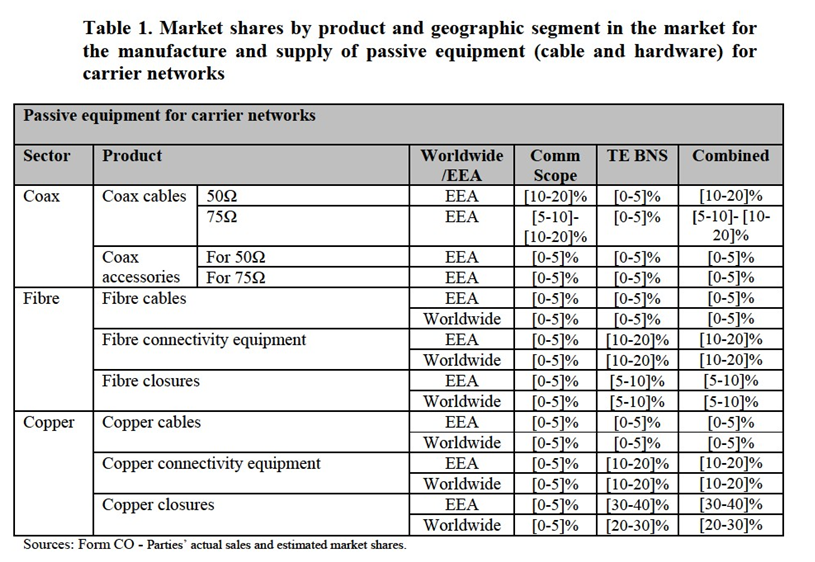
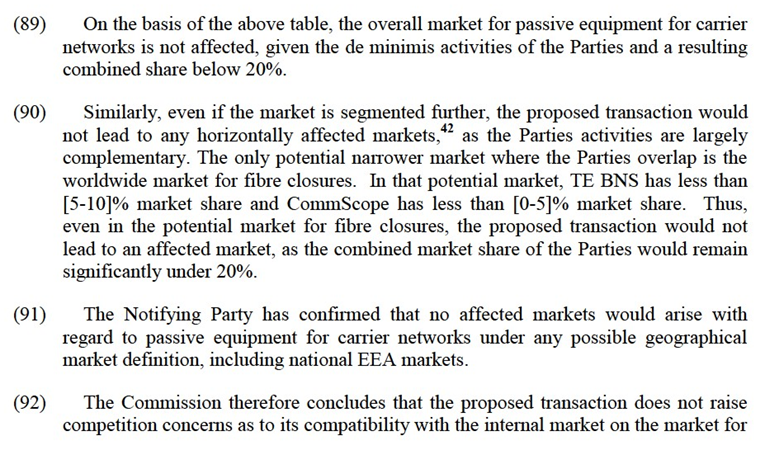
the manufacture and supply of passive equipment (cable and hardware) for carrier networks and any potential narrower markets.
5.2.The overall market for the manufacture and supply of passive equipment (cable and hardware) for enterprise networks and potential narrower markets.
(93) On the market for the manufacture and supply of passive equipment (cable and hardware) for enterprise networks, the proposed transaction would lead to affected markets, where the Parties have a combined share above 20%, in the above potential narrower markets: (i) overall (i.e., shielded and unshielded) copper cables for enterprise networks, (ii) overall (i.e., shielded and unshielded) copper hardware for enterprise networks; (iii) unshielded copper cables for enterprise networks, (iv) unshielded copper hardware for enterprise networks; and (v) fibre hardware for enterprise networks.
5.2.1.The Notifying Party's views
(94) The Notifying Party argued that both on the overall market and on all narrower potential markets, there is a large number of strong competitors. Following the transaction, there would remain a significant number of competitors in the market, leaving customers with ample opportunity to switch.
(95) The Notifying Party argued that competitors are active in all potentially affected product markets – namely copper cables (overall and unshielded), copper hardware (overall and unshielded) and fibre hardware. Thus, the competitive analysis is applicable to all potentially affected markets. In addition, the competitive assessment applies to further potential narrower markets such as copper cables of different performance categories or shielding types and the corresponding hardware and single- mode and multi-mode fibre cables.
(96) Some competitors, such as Daetwyler, Leoni, Kerpen and the Prysmian group are particularly strong in shielded cables, while Belden, Nexans and lS Cable are strong in unshielded cables. In addition, R&M, Mets Connect GmbH and 3M are particularly strong in shielded hardware, while Panduit, Legrand and Leviton are more active in unshielded hardware.
(97) According to the Notifying Party, the market is not concentrated, with a significant number of independent competitors. The Notifying Party also argued that private labels have been increasing slowly but steadily in the past years.
(98) In addition, the Notifying Party argued that purchasers of cable and hardware for enterprise networks have strong buyer power. Customers include large distributors, system integrators, large corporations as well as established wireless carriers.
(99) Furthermore, CommScope submitted that most of its enterprise sales are indirect and made through Anixter, an established distributor recognised as a global supplier of communications and security products, electrical and electronic wire and cable, fasteners and other small components. Anixter also distributes products from many of the Parties’ competitors, as a result of its position and its various sources of supply from different solutions partners, Anixter can put the different providers of cable and hardware for enterprise networks in competition.

 INSERER IMAGE 3+4+5
INSERER IMAGE 3+4+5

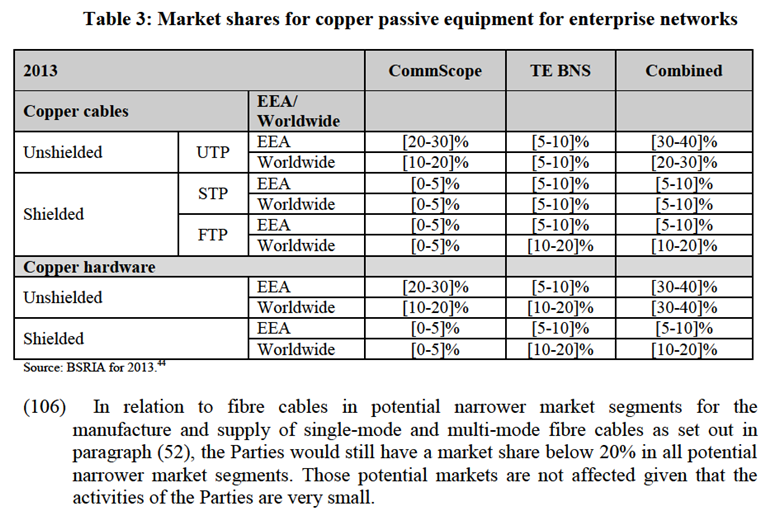
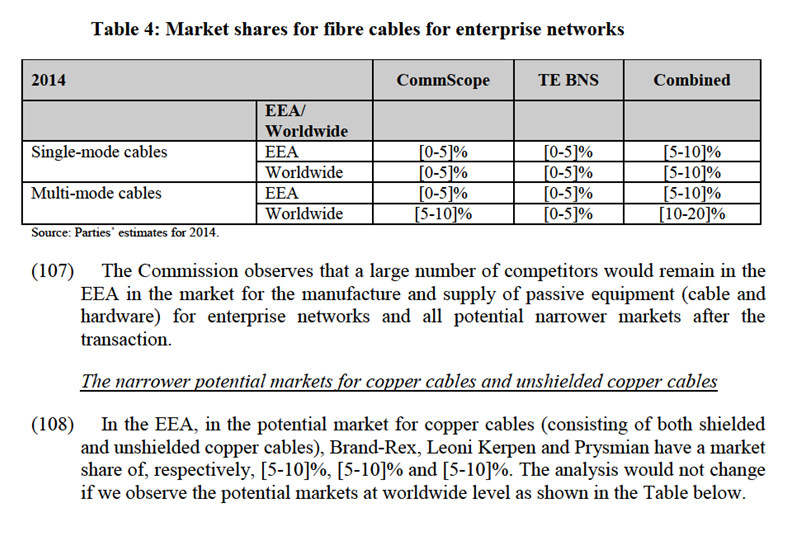
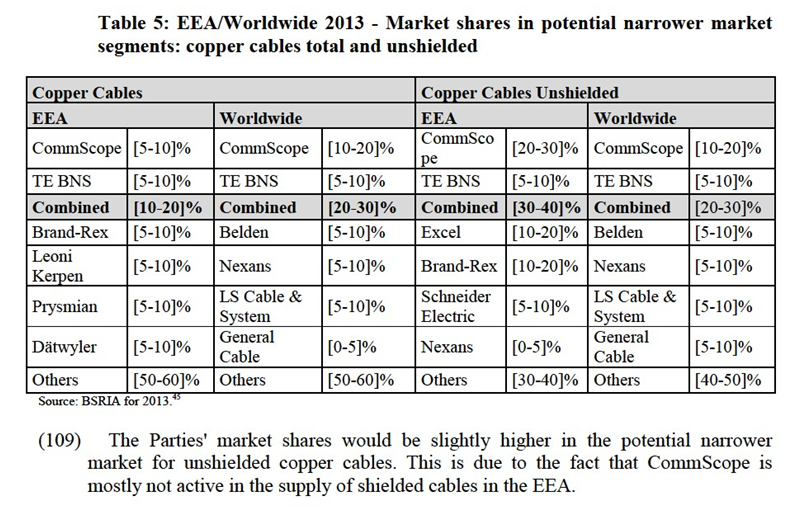


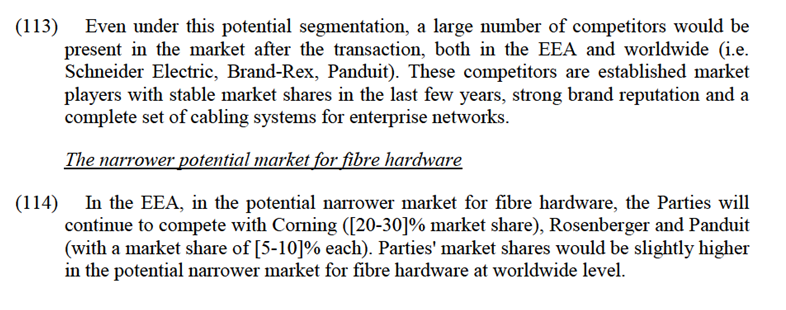
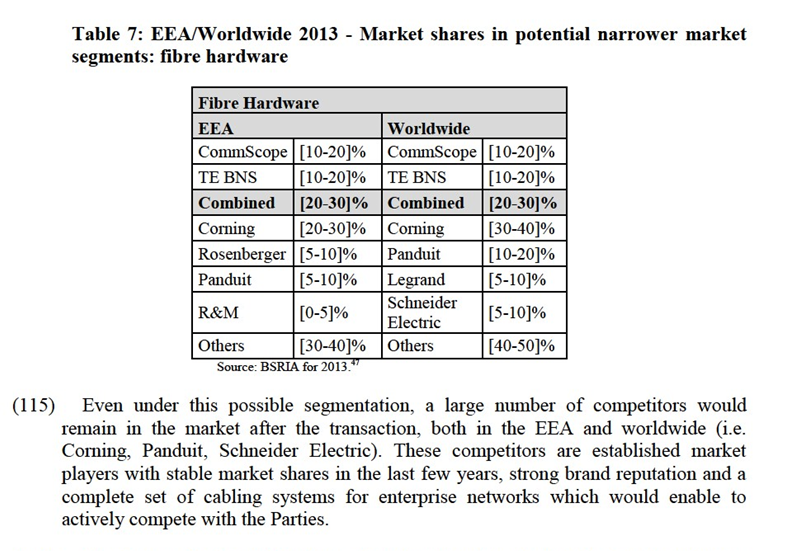
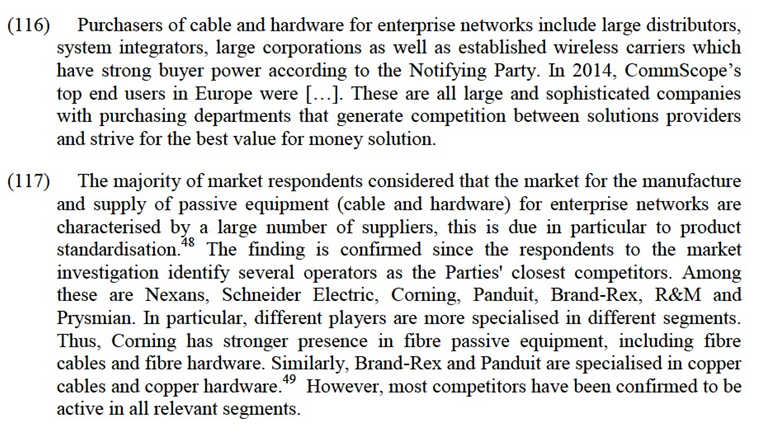 (118) Product standardisation enables the presence of a large number of competitors. Market respondents highlighted that there is a difference between providers based on the different value they provide to customers. Some respondents considered that certain white label manufacturers of cabling, especially from Asia, might not offer such high quality cables and hardware as the established branded manufacturers. However, all large branded manufacturers (i.e., Corning, Panduit, etc.) are able to offer cabling systems which may compete and even in some cases outperform by quality and performance the offering of the Parties.50
(118) Product standardisation enables the presence of a large number of competitors. Market respondents highlighted that there is a difference between providers based on the different value they provide to customers. Some respondents considered that certain white label manufacturers of cabling, especially from Asia, might not offer such high quality cables and hardware as the established branded manufacturers. However, all large branded manufacturers (i.e., Corning, Panduit, etc.) are able to offer cabling systems which may compete and even in some cases outperform by quality and performance the offering of the Parties.50
(119) The majority of respondents sell their products mainly through indirect channels, composed by distributors and installers,51 while tenders are launched for larger building infrastructure projects. Those tenders are launched on a frequent basis, usually monthly, both for greenfield and brownfield projects.52 The duration of the projects is typically dependant of the size of the project which may be up to three years.53 On the other hand, price, reputation and product portfolio are the main factors on which customers base their choice.54 One of the customers replied that, in choosing different suppliers, it considers products of similar quality and performance from three manufacturers and among those choose the one with the most competitive price.55
(120) Both customers and competitors confirmed that various suppliers can be present on the same site and that there are no interoperability problems due to product standardisation.56 While customers consider it possible to switch suppliers for major replacements or upgrades / extensions, this is not usual due to significant cost to upgrade an existing network infrastructure and since switching components would usually invalidate system warranties.57
(121) Entry in the market is not dependent on technical requirements but it is mainly constrained by brand reputation and time-to-market which makes entry more difficult for companies that want to offer complete enterprise network solutions.58 The majority of market respondents also consider the market to be characterised by the presence of sophisticated customers with strong buyer power leading to intense competition with a part of them differentiating between small projects based on standard products and large projects characterised by a higher level of customisation where customers tend to have lower buyer power.59
(122) The totality of the customers responding to the market investigation does not think that the transaction would have any impact on the market for the manufacture and sale of passive equipment for enterprise network neither in the segments for copper cables, copper hardware and fibre hardware.60 One customer highlights that the transaction would enable CommScope to broaden its activities in relation to the copper shielded products.61
(123) Competitors are split on the impact of the proposed transaction, with a small majority suggesting that there will not be significant change to competition in the market. A few respondents note that the merging of the number one and number two in the market will create a dominant player. Other competitors argue that the proposed transaction would enable significant cost reduction and ultimately price reductions.62 The majority of respondents, however, note that, even with the combined CommScope/TE BNS, there will be sufficient credible alternatives to the Parties.63
(124) Some market respondents believe that the merged entity will be in a position to control the technical development of both copper and fibre passive equipment and influence the standard setting bodies. One competitor expressed concerns that the combined voting powers of CommScope and TE BNS will influence the standard setting process.64
(125) In relation to the Parties' ability to influence the standard setting process in relation to enterprise cables and hardware, another competitor did not consider that this was a credible concern. Both CommScope and TE are active in the standard setting process, as are other cable and hardware providers. However, aside from the cable / hardware manufacturers, there are many different stakeholders involved in the standard setting process, such as customers and industry experts. It is therefore not easy for one company, even a strong one, to affect significantly the standard setting process.65
(126) The Commission's investigation has established that it is highly unlikely that CommScope would be able to control future technical development since, in the international committees where CommScope and TE BNS are present (ISO, Cenelec, IEC), a large majority of votes is needed to approve a standard.
(127) ISO is an international standard body composed by several national ISO member bodies. Decisions are taken within ISO on the basis of votes cast by ISO member bodies, using the principle of one country, one vote. A standard is approved as an International Standard (IS) if a two-thirds majority of the participants of the technical committee or subcommittee is in favour and not more than one-quarter of the total number of votes cast are negative.66 The same majority of two-thirds of voting in favour and not more than one-quarter of the total against are also needed in the voting process for IEC standards.67
(128) A similar process is needed to approve a European Standard (EN) through Cenelec. Member countries have weighted votes corresponding to the size of the country they represent. For instance, the larger countries like France, Germany, Italy and the UK have 29 votes each while the smallest ones have three weighted votes. There are two requirements for a standard to be approved. The vote must yield a majority of national committees in favour of the document and at least 71% of the weighted votes cast are positive.68
5.2.3.Conclusion
(129) The Commission therefore concludes that the proposed transaction does not raise serious doubts as to its compatibility with the internal market on the market for the manufacture and supply of cable and hardware for enterprise networks or any potential narrower markets.
5.3. The overall market for the manufacture and supply of telecommunications equipment for wireless coverage and capacity solutions and potential narrower markets
(130) On the market for the manufacture and supply of telecommunications equipment for wireless coverage and capacity solutions, the proposed transaction would lead to affected markets, where the Parties have a combined share above 20%, in the above potential narrower markets: (i) DAS_+ Small cells, (ii) DAS only (i.e., including active and passive DAS); and (iii) active DAS only.
5.3.1.The Notifying Party's views
(131) The Notifying Party argued that the competitive assessment for the overall market for telecoms equipment for wireless coverage and capacity solutions also applies to the assessment for a narrower DAS, small cells and low power RHHs market. The reason is that these solutions are to a large extent substitutable.
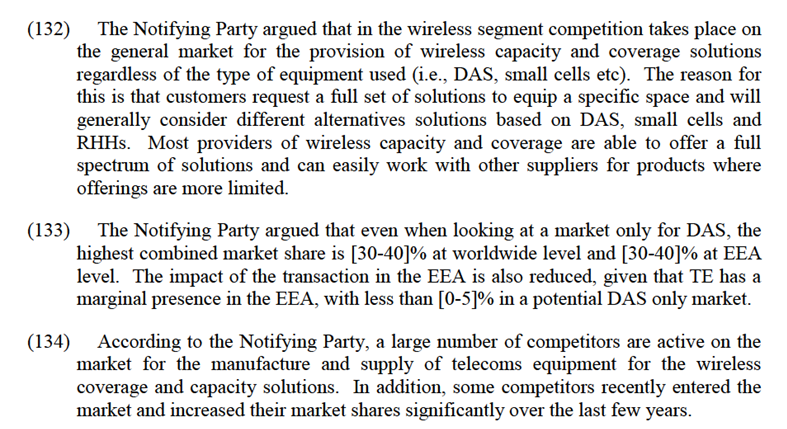
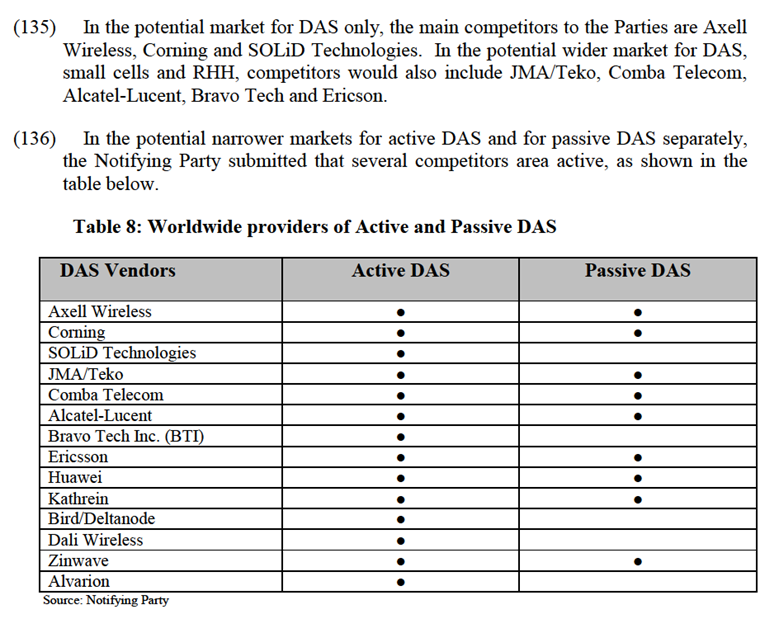

Party argued that Ericsson and Comba are examples of passive DAS providers that switched, or are in the process of switching to producing active DAS.
(138) The Notifying Party submitted that […]. The Notifying Party argued that CommScope and TE BNS’s DAS solutions are similar to their competitors’ products. In particular, DAS vendors such as Dali Wireless offer similar digital DAS products while DAS vendors such as Corning and JMA/Teko offer similar DAS products resorting to analogue technology.
(139) The Notifying Party argued that the market is characterised by strong countervailing buyer power. CommScope and TE BNS sell wireless capacity and coverage solutions to large providers, including large mobile carriers and large corporations.
(140) According to the Notifying Party, a number of new players have entered the market in the past years and the quick take-offs of these new entrants is evidence that the market is dynamic and has low entry barriers. The Notifying Party notes the entry of Alvarion, which entered the market in 2011 in carrier grade Wi-Fi, Zinwave, a global provider of in-building wireless coverage providing solutions for hospitals, stadiums, shopping malls, airports and power stations, Dali Wireless, a Silicon Valley-based company, which provides DAS solutions through its "t-series", SpiderCloud Wireless, another Silicon Valley-based company, which is a small cell managed services platform for enterprises with a controller connected to access points and Kathrein, which is known for macro-base station antennas and small cells and antennas and which recently entered the DAS segment.
(141) The Notifying Party also submitted that strong vendors such as Ericsson, Alcatel Lucent, Nokia Network Solutions (NSN) would require only a minor investment to enter the market as they already hold manufacturing sites and a supplier base besides available capital. In fact, in late 2013, Ericsson launched its small cell Radio DOT System while Huawei Technologies introduced LampSite and were able to increase their capacity levels very quickly.
5.3.2.The results of the market investigation and the Commission's assessment
(142) On the market for the manufacture and supply of telecommunications equipment for wireless coverage and capacity solutions, the proposed transaction will lead to affected markets, since the Parties have a combined share above 20%. In particular, the combined entity will have a combined market share of [30-40]% in the potential worldwide market for DAS.
(143) The table below shows the market shares of the Parties in the EEA and worldwide based on the Mobile Experts report submitted by the Parties.
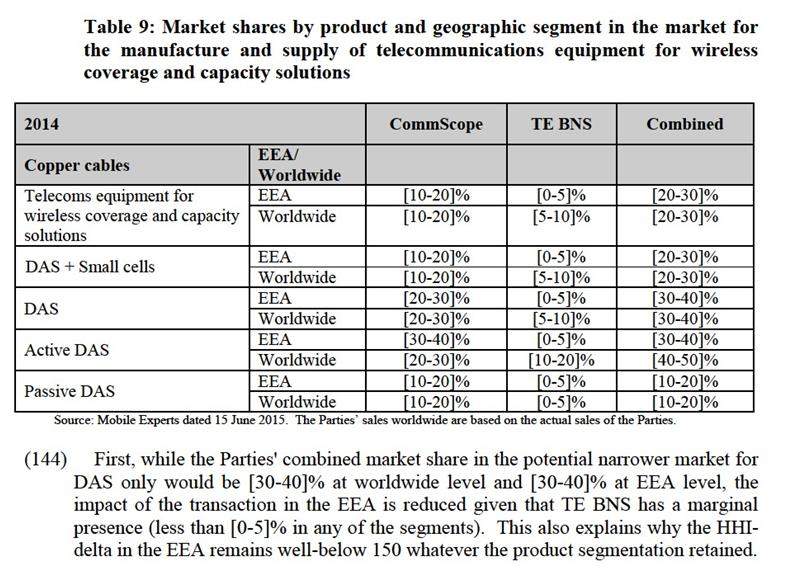
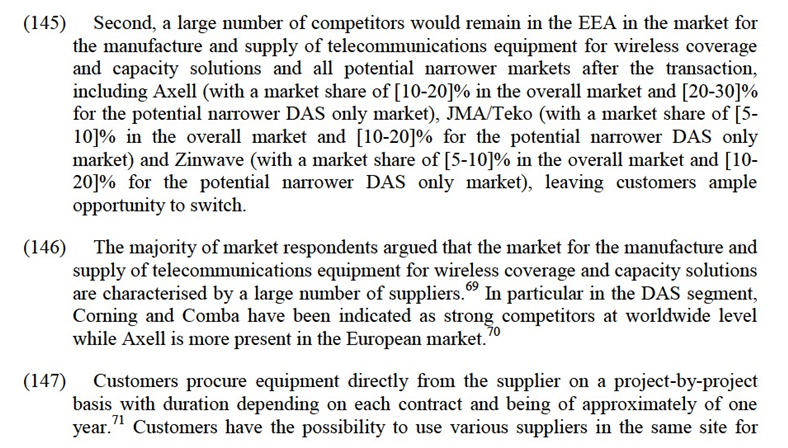
their wireless need but, usually, they tend to use just one supplier for each specific type of equipment (i.e. DAS, Small cells, etc.).72
(148) On the other hand, switching is not easy due to interoperability problems.73 The possibility to enter the market is constrained due to the high R&D and manufacturing investments and necessary reputation needed to acquire customers settled with other operators.74
(149) The majority of market respondents had no concerns on the impact that the proposed transaction would have on the market for the manufacture and supply of telecommunications equipment for wireless coverage and capacity solutions and any potential narrower markets.
(150) However, one competitor highlighted that CommScope will become the biggest player in the market.75 In particular, in a potential narrower market for DAS only or for active DAS only, as set out in paragraphs (80) and (81) above, the merged entity will be the strongest competitor. On a worldwide basis, the merged entity will have a [30-40]% market share for DAS and a [40-50]% market share for active DAS only. However, after the transaction a number of other worldwide competitors will remain in the market, such as Corning, Comba, SOLiD, Axell, Bird, Teco and Zinwave.
(151) In an EEA-wide market for DAS only or active DAS only, there are fewer competitors active. However, TE BNS's presence on this market is marginal, with only [0-5]% market share in DAS and [0-5]% market share in active DAS. Therefore, the increment resulting from the transaction is negligible and will not have an impact on competition in an EEA-wide market. The main competitor in the EEA is Axell, in addition to smaller competitors such as JMA/Teko, Zinwave, Comba, Corning, Bird and SOLiD. In relation to active DAS, the following competitors would remain in the market post transaction: JMA/Teko, Axell Wireless, SOLiD, Comba, and Corning.76
(152) In addition, geographic entry in the EEA market for active DAS is possible and anticipated, The Commission notes that the list of competitors presented in Table 8 above includes companies providing active and passive DAS worldwide, and thus includes companies which are not currently active in the EEA. However, these companies may be considered potential entrants and exercise a competitive constraint on the operators active in the EEA. A number of respondents to the Commission's investigation refer to potential entrants. One mobile carrier referred to a future expected entry in active DAS in the EEA.77 In addition, one competitor active in the EEA argued that DAS providers which are not currently active in the EEA can enter the EEA market, as they have the relevant expertise to move from one region to the other.78
(153) Third, purchasers of wireless coverage and capacity solutions include large mobile network operators and large corporations which have strong buyer power and the ability to play suppliers against each other.
(154) In 2014, the Parties’ largest customers were […], all large and sophisticated companies with purchasing departments that can play out solutions providers against each other to obtain the best commercial conditions. In the market and each of its potential sub-segments of DAS, small cells and RRH, customers usually have two, three or more vendors at a time with whom they maintain continuous business relationships in order to switch when unsatisfied or in the event of a price increase.
(155) One competitor argued that not all DAS suppliers or active DAS suppliers were approved to supply the high end of the market for telecoms carriers in the EEA. Mobile telecoms operators have higher requirements to other customers, such as municipalities and corporations. This competitor considered that only CommScope, TE and Axell were able to meet the technical requirements of the large telecoms carriers.79 In any event, the same competitor considered that the mobile network operators had significant market power and that they could impose their standards and criteria on the relevant suppliers. In addition, a number of mobile carriers multi- source from three suppliers, to ensure security of supply. Thus, if the transaction eliminates a selected supplier, the mobile telecoms carriers would be in a position to switch to another supplier.
(156) Contrary to the claims of the competitor above, one mobile carrier affirmed that it is currently sourcing its DAS from Kathrein and Huawei, rather than the Parties (or Axell) and that it expects another competitor to enter the market in the near future. On this basis, the telecoms carrier stated that it did not have concerns about the impact of the transaction on competition.80
(157) Lastly, the market has low barriers to entry and has seen a number of new entrants in the past years, in particular in the DAS segment where CommScope and TE BNS are mainly active. Zinwave, who launched its first commercial product in 2009, today has a market share of [10-20]%; Kathrein, established player in the macro base station and small cell antennas with strong relationships with large customers as Ericsson, recently also launched its DAS solution.
(158) The market investigation confirmed that in the next two to three years entry in these markets is likely81 and that new entrants are successful in obtaining contracts with large mobile telecoms carriers.82
5.3.3.Conclusion
The Commission therefore concludes that the proposed transaction does not raise serious doubts as to its compatibility with the internal market on the market for the manufacture and supply of telecommunications equipment for wireless coverage and capacity solutions and any potential narrower markets.
6.CONCLUSION
(159) For the above reasons, the European Commission has decided not to oppose the notified operation and to declare it compatible with the internal market and with the EEA Agreement. This decision is adopted in application of Article 6(1)(b) of the Merger Regulation and Article 57 of the EEA Agreement.
1 OJ L 24, 29.1.2004, p. 1 ('the Merger Regulation'). With effect from 1 December 2009, the Treaty on the Functioning of the European Union ('TFEU') has introduced certain changes, such as the replacement of 'Community' by 'Union' and 'common market' by 'internal market'. The terminology of the TFEU will be used throughout this decision.
2 OJ L 1, 3.1.1994, p. 3 ("the EEA Agreement").
3 The definition of shares includes all rights, titles and interest in and to certain entities ultimately controlled by TE Connectivity Ltd (for example Tyco Electronics Denmark A/S. River Italia Holding S.r.l., ADC Europe N.V., ADC Czech Republic, s.r.o., ADC Telecommunications (Shanghai) Distribution Co., Ltd., etc).
4 The definition of assets includes certain assets, properties and rights owned, ultimately controlled by TE Connectivity Ltd. Those assets include real estate properties, tangible personal properties, contracts, IT and other assets included in the Stock and Asset Purchase agreement. Those assets are spread across the world (for example the United States, China, Spain, Germany, France, the Netherlands, Switzerland, etc.).
5 Commission decision of 9 December 2010 in Case M.6057 – Carlyle/CommScope.
6 Turnover calculated in accordance with Article 5 of the Merger Regulation.
7 Commission decision of 31 March 2000 in Case M.1880 - 3M/ Quante, paragraph 10; Commission decision of 6 December 2010 in Case M.5983 - Tyco Electronics / ADC Telecommunications, paragraphs 8-21 and Commission decision of 3 December 2007 in Case M.4819 - Commscope / Andrew, paragraphs 11-16.
8 Commission decision of 3 December 2007 in Case M. 4819 - Commscope / Andrew, paragraphs 11-16.
9 The ohm (symbol: Ω) is the standard derived unit of electrical resistance. The ohm is the electric resistance between two points of a conductor when a constant potential difference of 1 volt, applied to these points, produces in the conductor a current of 1 ampere, the conductor not being the seat of any electromotive force.
10 Commission decision of 6 December 2010 in Case M.5983- Tycos Electronics/ADC Telecommunications, paragraph 12.
11 Commission decision of 6 December 2010 in case M.5983 - Tycos Electronics/ADC Telecommunications, paragraphs 8-21.
12 Commission decision of 6 December 2010 in case M.5983 - Tycos Electronics/ADC Telecommunications, paragraph 21; Commission decision of 3 December 2007 in Case M.4819 Commscope / Andrew paragraph 11-16.
13 Commission decision of 6 December 2010 in Case M.5983 – Tyco Electronics / ADC Telecommunications, paragraph 24; Commission decision of 3 December 2007 in Case M.4819 Commscope / Andrew paragraph 18-23. Commission decision of 31 March 2000 in Case M.1880 - 3M/ Quante; Commission decision of 6 January 2006, paragraph 15; Commission decision of 6 January 2006 in Case M.4050 - Goldman Sachs/Cinven/Ahlsell, paragraph 9; Commission decision of 20 September 2001 in Case M.2574 - Pirelli/Edizione/Olivetti/Telecom Italia, para. 38; Commission decision of 5 July 2005 in Case M.3836 - Goldman Sachs/Pirelli Cavi e Sistemi Telecom, paragraph 20; Commission decision of 16 November 1999 in Case M.1711 - Tyco/Siemens, paragraph 11; Commission decision of 15 September 2008 in Case M.5255 - TDK Corporation/EPCOS, paragraph 19.
14 Commission decision of 31 March 2000 in Case M.1880 - 3M/ Quante, paragraph 10; Commission decision of 6 December 2010 in Case M.5983 - Tyco Electronics / ADC Telecommunications, paragraphs 8-21 and Commission decision of 3 December 2007 in Case M.4819 - Commscope / Andrew, paragraphs 11-16.
15 Networks within buildings.
16 Data centres are the physical structures where enterprises, carriers and other entities house their servers and connect to other entities’ networks.
17 Conference call with a distributor: "Non confidential minutes - Conference call with a distributor", dated 2 June 2015; Conference call with a distributor: "Non confidential minutes - Conference call with a distributor", dated 5 June 2015; Conference call with a competitor: "Non confidential minutes - Conference call with a competitor", dated 1 June 2015; Conference call with a distributor: "Non confidential minutes - Conference call with a distributor", dated 9 June 2015.
18 Commission decision of 31 March 2000 in Case M.1880 - 3M/ Quante, paragraph 10; Commission decision of 6 December 2010 in Case M.5983 - Tyco Electronics / ADC Telecommunications, paragraphs 8-21 and Commission decision of 3 December 2007 in Case M.4819 - Commscope / Andrew, paragraphs 11-16.
19 See replies to Commission questionnaires to competitors Q1 and to customers Q2 of 22 May 2015, question 4.
20 See replies to Commission questionnaires to competitors Q1 and to customers Q2 of 22 May 2015, question 5.
21 See replies to Commission questionnaire to competitors Q1 of 22 May 2015, question 6.
22 See replies to Commission questionnaire to customers Q2 of 22 May 2015, question 7.
23 See replies to Commission questionnaires to competitors Q1 and to customers Q2 of 22 May 2015, questions 7 and 12.
24 See replies to Commission questionnaire to customers Q2of 22 May 2015, questions 8, 9, 10 and 11.
25 See replies to Commission questionnaire to competitors Q1 of 22 May 2015, questions 8, 9, 10 and 11.
26 Conference call with a distributor: "Non confidential minutes - Conference call with a distributor", dated 2 June 2015; Conference call with a distributor: "Non confidential minutes - Conference call with a distributor", dated 5 June 2015; Conference call with a competitor: "Non confidential minutes - Conference call with a competitor", dated 1 June 2015; Conference call with a distributor: "Non confidential minutes - Conference call with a distributor", dated 9 June 2015.
27 See replies to Commission questionnaires to competitors Q1 and to customers Q2 of 22 May 2015, question 9.
28 See replies to Commission questionnaires to competitors Q1 and to customers Q2 of 22 May 2015, question 14.
29 See replies to Commission questionnaires to competitors Q1 and to customers Q2 of 22 May 2015, question 13.
30 Commission decision of 31 March 2000 in Case M.1880 - 3M/ Quante; Commission decision of 6 January 2006, paragraph 15; Commission decision of 6 December 2010 in Case M.5983 – Tyco Electronics / ADC Telecommunications, paragraph 24; Commission decision of 6 January 2006 in Case M.4050 - Goldman Sachs/Cinven/Ahlsell, paragraph 9; Commission decision of 20 September 2001 in Case M.2574 - Pirelli/Edizione/Olivetti/Telecom Italia, para. 38; Commission decision of 5 July 2005 in Case M.3836 - Goldman Sachs/Pirelli Cavi e Sistemi Telecom, paragraph 20; Commission decision of 16 November 1999 in Case M.1711 - Tyco/Siemens, paragraph 11; Commission decision of 15 September 2008 in Case M.5255 - TDK Corporation/EPCOS, paragraph 19.
31 See replies to Commission questionnaires to competitors Q1 and to customers Q2 of 22 May 2015, question 21.
32 Conference call with a distributor: "Non confidential minutes - Conference call with a distributor", dated 2 June 2015; Conference call with a distributor: "Non confidential minutes - Conference call with a distributor", dated 5 June 2015; Conference call with a competitor: "Non confidential minutes - Conference call with a competitor", dated 1 June 2015; Conference call with a distributor: "Non confidential minutes - Conference call with a distributor", dated 9 June 2015.
33 Commission decision of 15 December 2010 in Case M.6007 Nokia Siemens Networks/Motorola Network Business, paragraphs 10-12.
34 RAN performs the radio functions of the mobile network by providing the radio access between the mobile handset and the mobile network via multiple transceiver stations and a smaller number of base station controllers.
35 Commission decision of 6 December 2010 in Case M.5983 - Tyco Electronics / ADS Telecommunications, footnote 4.
36 See replies to Commission questionnaire to competitors Q1 of 22 May 2015, question 17.
37 See replies to Commission questionnaires to competitors Q1 and to customers Q2 of 22 May 2015, questions 15 and 16.
38 See replies to Commission questionnaires to competitors Q1 and to customers Q2 of 22 May 2015, question 18.
39 Conference call with a competitor: "Non confidential minutes - Conference call with a competitor", dated 5 June 2015; Conference call with a competitor: "Non confidential minutes - Conference call with a competitor", dated 5 June 2015; Conference call with a competitor: "Non confidential minutes - Conference call with a competitor", dated 8 June 2015.
40 See replies to Commission questionnaires to competitors Q1 and to customers Q2 of 22 May 2015, question 20.
41 See replies to Commission questionnaires to competitors Q1 and to customers Q2 of 22 May 2015, question 22.
42 The Commission considers the market to be horizontally affected when two or more of the parties to the concentration are engaged in business activitiesin the same relevant market and where the concentration will lead to a combined market share of 20% or more. See, e.g. Annex1 to the Commission Regulation (EC) N°802/2004 of 21 April 2004 inplementing Council Regulation (EC) n° 139/2004 on the control of concentrations between undertakings (« Implementing Regulation »), as amended.
43 Source BSRIA for 2013. Please note that BSRIA covers only 13 EEA countries, namely : Austria, Belgium, Denmark, Germany, Finland, France, Italy, the Netherlands, Norway, Spain,Sweden, Poland and the UK.
44 Source BSRIA for 2013. Please note that BSRIA covers only 13 EEA countries, namely : Austria, Belgium, Denmark, Germany, Finland, France, Italy, the Netherlands, Norway, Spain,Sweden, Poland and the UK.
45 Source BSRIA for 2013. Please note that BSRIA covers only 13 EEA countries, namely : Austria, Belgium, Denmark, Germany, Finland, France, Italy, the Netherlands, Norway, Spain,Sweden, Poland and the UK.
46 Source BSRIA for 2013. Please note that BSRIA covers only 13 EEA countries, namely : Austria, Belgium, Denmark, Germany, Finland, France, Italy, the Netherlands, Norway, Spain,Sweden, Poland and the UK.
47 Source BSRIA for 2013. Please note that BSRIA covers only 13 EEA countries, namely : Austria, Belgium, Denmark, Germany, Finland, France, Italy, the Netherlands, Norway, Spain,Sweden, Poland and the UK.
48 See replies to Commission questionnaires to Competitors Q1 and to customers Q2 of 2 May 2015, question 24.
49 See replies to Commission questionnaires to Competitors Q1 and to customers Q2 of 2 May 2015, question 25.
50 See replies to Commission questionnaires to competitors Q1 and to customers Q2 of 22 May 2015, question 26.
51 See replies to Commission questionnaire to competitors Q1 of 22 May 2015, questions 27 and 29 and questionnaire to customers Q2 of 22 May 2015, questions 27 and 32.
52 See replies to Commission questionnaire to competitors Q1 of 22 May 2015, question 28.
53 See replies to Commission questionnaire to competitors Q1 of 22 May 2015, question 34 and questionnaire to customers Q2 of 22 May 2015, question 38.
54 See replies to Commission questionnaire to competitors Q1 of 22 May 2015, question 33 and questionnaire to customers Q2 of 22 May 2015, question 37.
55 Conference call with a distributor: "Non confidential minutes - Conference call with a distributor", dated 2 June 2015.
56 See replies to Commission questionnaire to competitors Q1 of 22 May 2015, question 31 and questionnaire to customers Q2 of 22 May 2015, question 34.
57 See replies to Commission questionnaire to competitors Q1 of 22 May 2015, question 32 and questionnaire to customers Q2 of 22 May 2015, question 36.
58 See replies to Commission questionnaire to competitors Q1 of 22 May 2015, question 35 and questionnaire to customers Q2 of 22 May 2015, question 39.
59 See replies to Commission questionnaire to competitors Q1 of 22 May 2015, questions 37 and 38.
60 See replies to Commission questionnaire to customers Q2 of 22 May 2015, question 52.
61 Conference call with a distributor: "Non confidential minutes - Conference call with a distributor", dated 2 June 2015.
62 See replies to Commission questionnaire to competitors Q1 of 22 May 2015, question 51.
63 Conference call with a competitor: "Non confidential minutes - Conference call with a competitor", dated 8 June 2015; Conference call with a distributor: "Non confidential minutes - Conference call with a distributor", dated 2 June 2015; Conference call with a distributor: "Non confidential minutes - Conference call with a distributor", dated 5 June 2015; Conference call with a distributor: "Non confidential minutes - Conference call with a distributor", dated 4 June 2015; Conference call with a competitor: "Non confidential minutes - Conference call with a competitor ", dated 1 June 2015.
64 Conference call with a competitor: "Non confidential minutes - Conference call with a competitor", dated 1 June 2015.
65 Conference call with a competitor: "Non confidential minutes - Conference call with a competitor", dated 9 June 2015.
66 http://www.iso.org/sites/ConsumersStandards/voting_iso html
67 http://www.iec.ch/standardsdev/how/processes/development/enquiry.htm
68 http://www.cenelec.eu/aboutcenelec/whatwedo/standardsmakingprocess/index html
69 See replies to Commission questionnaire to competitors Q1 of 22 May 2015, question 39 and to customers Q2 of 22 May 2015, question 41.
70 See replies to Commission questionnaire to competitors Q1 of 22 May 2015, question 39 and to customers Q2 of 22 May 2015, question 42.
71 See replies to Commission questionnaire to competitors Q1 of 22 May 2015, question 39 and to customers Q2 of 22 May 2015, question 45.
72 See replies to Commission questionnaire to competitors Q1 of 22 May 2015, question 44 and to customers Q2 of 22 May 2015, question 46.
73 See replies to Commission questionnaire to competitors Q1 of 22 May 2015, question 45 and to customers Q2 of 22 May 2015, question 47.
74 See replies to Commission questionnaire to competitors Q1 of 22 May 2015, question 47.
75 See replies to Commission questionnaire to competitors Q1 of 22 May 2015, question 52 and to customers Q2 of 22 May 2015, question 53.
76 Conference call with a competitor: "Non confidential minutes - Conference call with a competitor ", dated 5 June 2015.
77 Non-confidential email from mobile carrier, dated 10 June 2015.
78 Conference call with a competitor: "Non confidential minutes - Conference call with a competitor ", dated 5 June 2015.
79 Conference call with a competitor: "Non confidential minutes - Conference call with a competitor", dated 8 June 2015.
80 Non-confidential email from mobile carrier, dated 10 June 2015.
81 Conference call with a competitor: "Non confidential minutes - Conference call with a competitor", dated 8 June 2015.
82 Non-confidential email from mobile carrier, dated 10 June 2015.